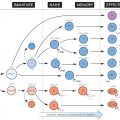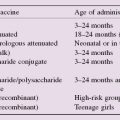The great majority of cells involved in mammalian immunity are derived from precursors in the bone marrow (left half of figure) and circulate in the blood, entering and sometimes leaving the tissues when required. A very rare stem cell persists in the adult bone marrow (at a frequency of about 1 in 100 000 cells), and retains the ability to differentiate into all types of blood cell. Haemopeoisis has been studied either by injecting small numbers of genetically marked marrow cells into recipient mice and observing the progeny they give rise to (in vivo cloning) or by culturing the bone marrow precursors in the presence of appropriate growth factors (in vitro cloning). Proliferation and differentiation of all these cells is under the control of soluble or membrane-bound growth factors produced by the bone marrow stroma and by each other (see Fig. 24). Within the cell these signals switch on specific transcription factors, DNA-binding molecules which act as master switches that determine the subsequent genetic programme, in turn giving rise to development of the different cell types (known as lineages). Remarkably, recent studies have shown that it is possible to turn one differentiated cell type into another by experimentally introducing the right transcription factors into the cell. This finding has important therapeutic implications, e.g. in curing genetic immunodeficiencies (see Fig. 33). Most haemopoietic cells stop dividing once they are fully differentiated. However, lymphocytes divide rapidly and expand following exposure to antigen. The increased number of lymphocytes specific for an antigen forms the basis for immunological memory.
A Note on Terminology
Haematologists recognize many stages between stem cells and their fully differentiated progeny (e.g. for red cells: proerythroblast, erythroblast, normoblast, erythrocyte). The suffix ‘blast’ usually implies an early, dividing, relatively undifferentiated cell, but is also used to describe lymphocytes that have been stimulated, e.g. by antigen, and are about to divide.
Bone Marrow
Unlike most other tissues or organs, the haemopoetic system is constantly renewing itself. In the adult, the development of haemopoetic cells occurs predominantly in the bone marrow. In the fetus, before bones develop, haemopoeisis occurs first in the yolk sac and then in the liver.
Stroma
Epithelial and endothelial cells that provide support and secrete growth factors for haemopoiesis.
S
Stem cell; the totipotent and self-renewing marrow cell. Stem cells are found in low numbers in blood as well as bone marrow and the numbers can be boosted by treatment with appropriate growth factors (e.g. G-CSF), which greatly facilitates the process of bone marrow transplantation (see Fig. 39).
LS
Stay updated, free articles. Join our Telegram channel

Full access? Get Clinical Tree





